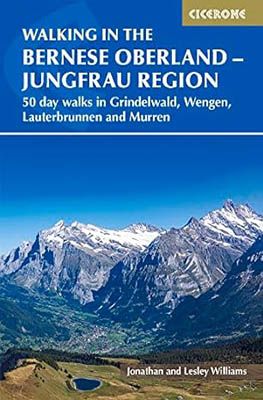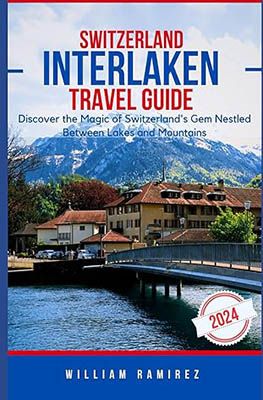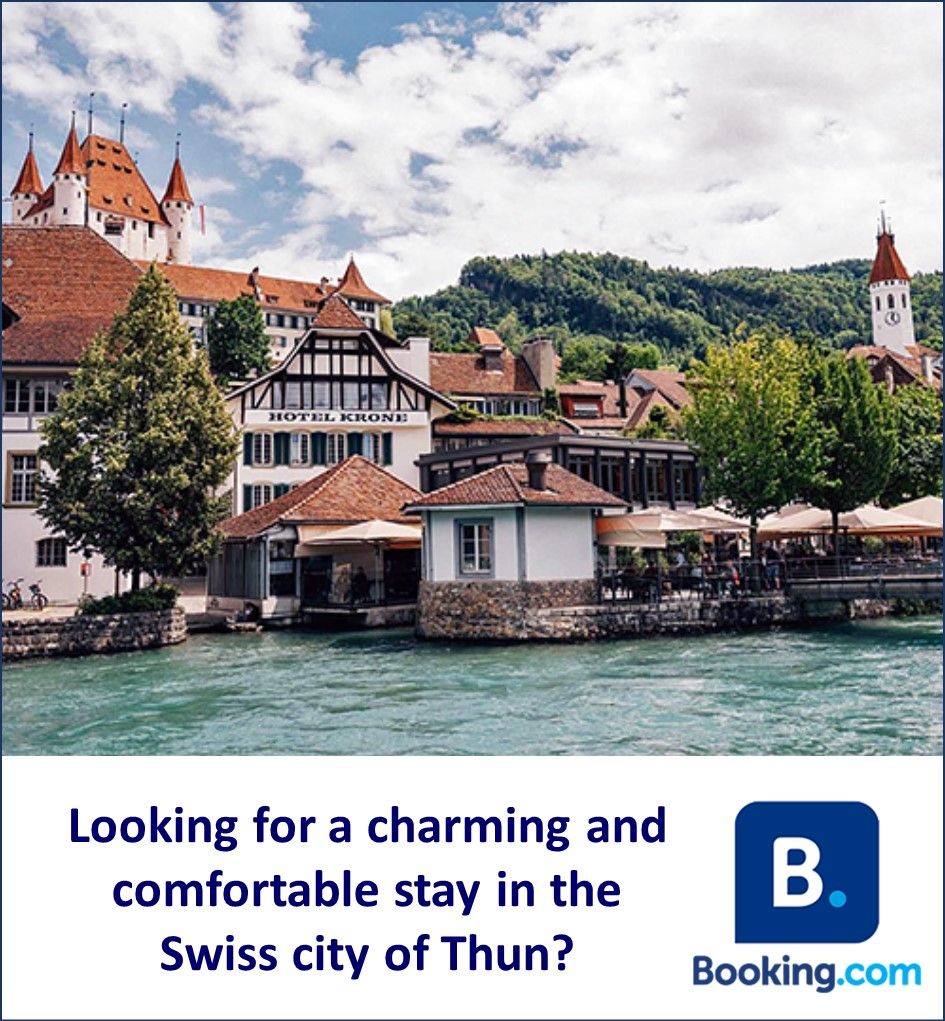City trip to Thun: Enjoying the city and its surroundings
City trip to Thun: Enjoying the city and its surroundings
Are you looking for a unique city trip? Then consider Thun, beautifully located on the shores of Lake Thun. It is a charming Swiss town that combines the rich history of a medieval city with the breathtaking beauty of the Alps. Whether you enjoy soaking up culture, hiking, cycling, or water sports, Thun has something for everyone. The unique combination of history, nature, and adventure makes Thun the perfect destination for an unforgettable city break.
The imposing Thun Castle is the city’s main attraction. The cobbled streets in the old town are surrounded by colorful houses, cozy cafes, and artisan shops. In the summer, you can even enjoy a genuine surfing culture as the city’s youth surfs on the Aare River. With the lake and the Alps in close proximity, you can have unforgettable experiences in the surrounding area. In this blog, we provide you with tips to make your city trip to Thun and its surroundings a delightful stay.
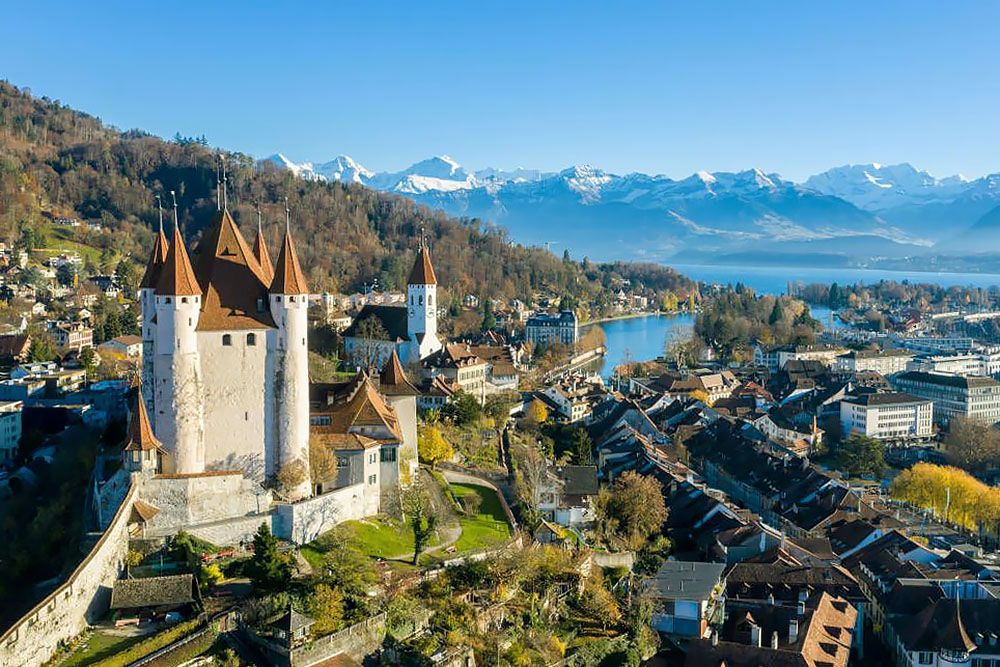
History of Thun
Thun in the canton of Bern exudes history. The area was inhabited as far back as Roman times. In the 12th century, Thun was granted city rights and grew into an important trading center. Its strategic location at the passage between the Alps and the Jura contributed to its growth.
Over the centuries, Thun was influenced by various rulers, including the Habsburgs and the Bernese. The imposing Thun Castle, built in the 12th century, bears witness to the city’s medieval history. Thun also played a role in the Reformation, with the introduction of Protestantism in the 16th century. Thun further developed as an important trading and industrial center in the 19th and 20th centuries.
Today, Thun is a charming city that attracts visitors due to its historical architecture, picturesque lakeside location, and proximity to the Swiss Alps. The rich history of Thun remains visible in the old buildings, streets, and cultural attractions. Thun has grown to become the 10th largest city in Switzerland. As a tourist destination, Thun is not yet widely known. However, we have found that Thun has a lot to offer.
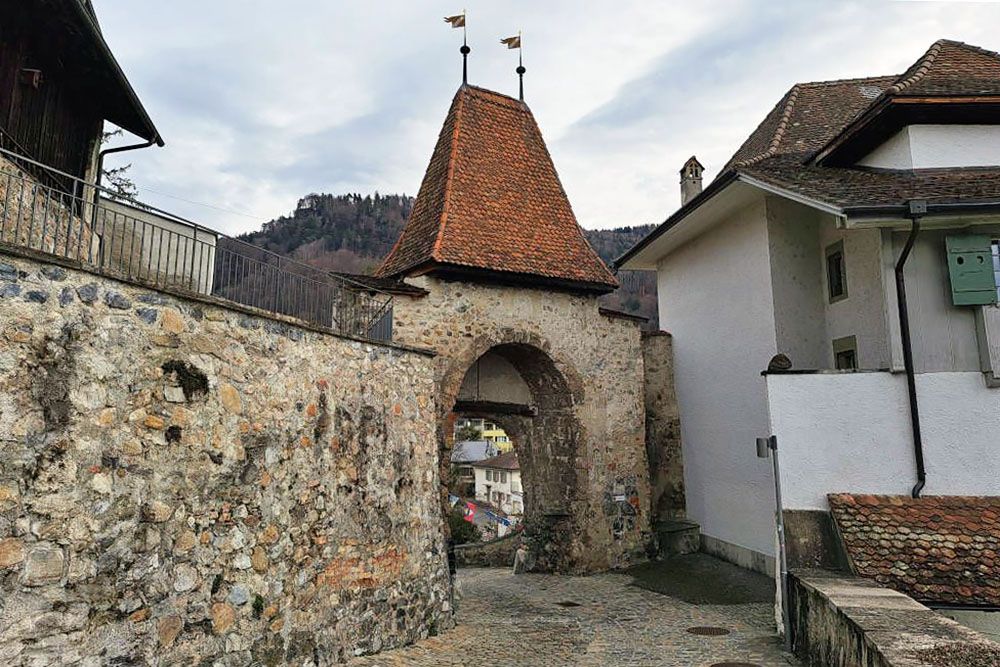
Highlights of Thun
Join us as we explore the main highlights of Thun.
Thun Castle
Thun Castle towers high above the city. It is an impressive medieval castle built around 1180, making it one of the oldest medieval castles in Switzerland. Originally, it served as the residence of the Dukes of Zähringen. The castle has an imposing appearance with its high towers, thick stone walls, and red roofs. Because it is situated on a hill, it requires a steep climb up various stairs to reach the castle. There is also a lift from the City Ost Schlossberg car park.
Over the centuries, the castle has served various functions, including as a residence for noble families, a prison, and an arsenal. One of the highlights of visiting the castle is the breathtaking view from the towers. The tower rooms now house a historical museum. Be sure to visit the knight’s hall from the 12th century, which is the most beautiful room in the castle.
 |
If the castle is closed and you still want to enjoy the view of Thun and its surroundings, then walk to the nearby Stadtkirche Thun. There you can also enjoy a beautiful panorama and as an added bonus, a good view of the castle! |
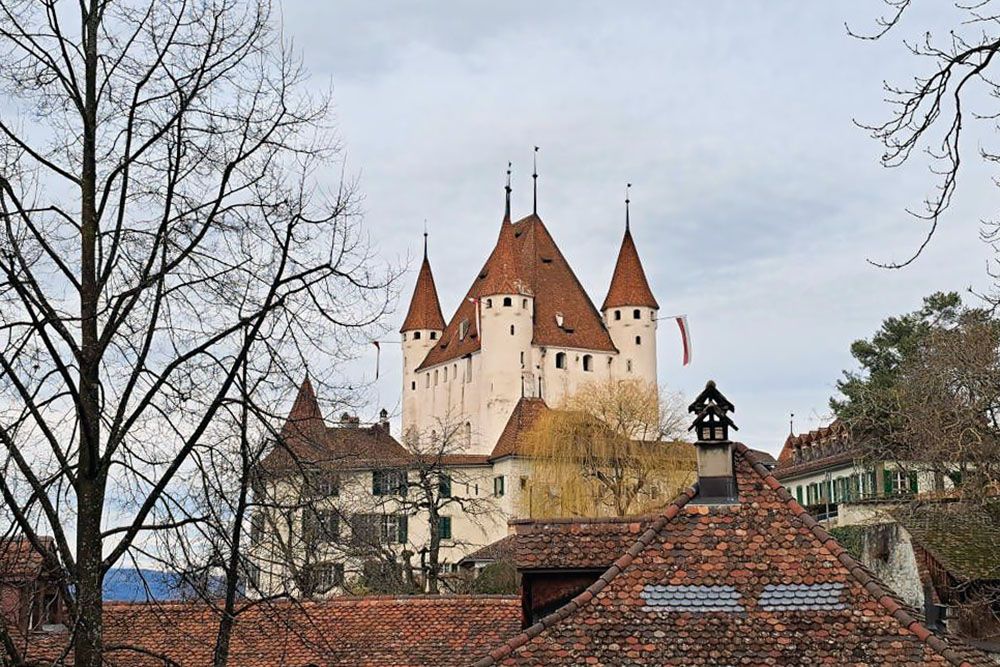
Schadau Castle
Schadau Castle is another remarkable building in Thun. It is located on the shores of Lake Thun, just outside the city center. Its location by the lake provides a picturesque setting. The castle was built in 1854 in a neo-Gothic style. The design is inspired by English castles and country houses. The castle is surrounded by an extensive park, a delightful place for a walk. The park’s English landscape style immediately catches the eye. Additionally, you can enjoy breathtaking views of Lake Thun and the surrounding Alpine giants.
For a romantic stay, book a hotel room at Schadau Castle, which now functions as a hotel. The restaurant at Schadau Castle is also well worth a visit and has an excellent reputation.
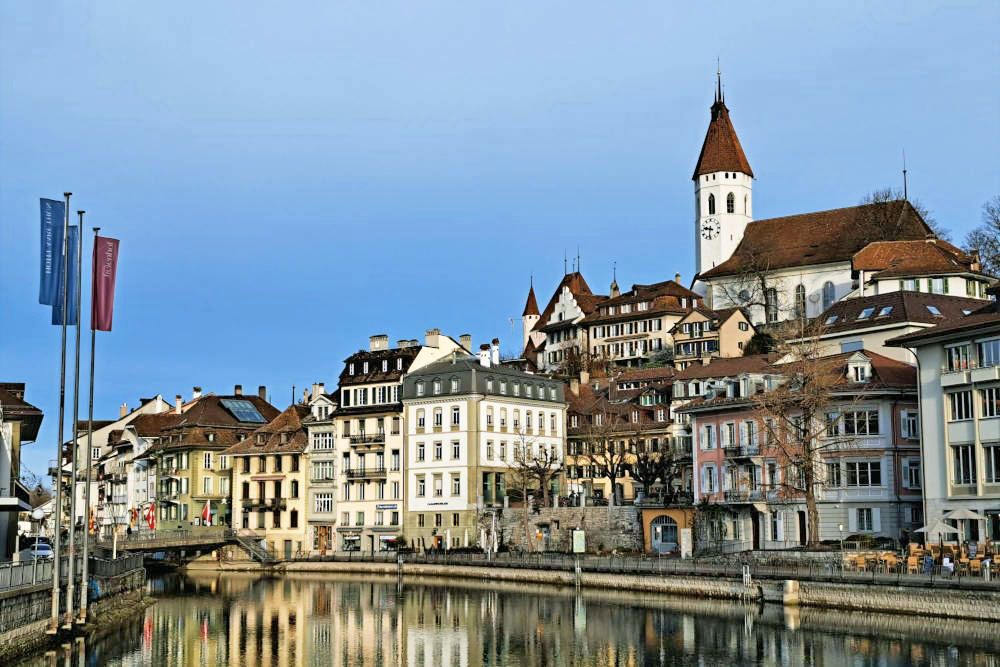
Historic city centre
The historic city centre of Thun is filled with historical architecture and a variety of shops, cafes, and restaurants. Stroll along the cobblestone streets and soak up the atmosphere of Thun’s Altstadt. Particularly notable are the raised sidewalks in the city centre, unique to Switzerland.
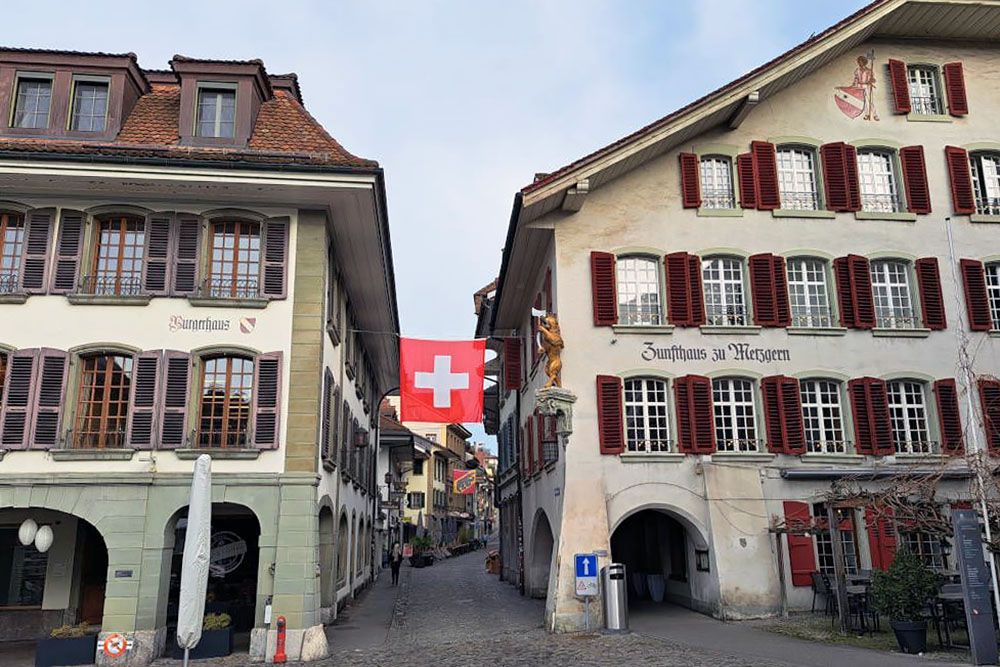
The main street is the Hauptgasse. This street is lined with colorful medieval buildings, boutiques, cafes, and restaurants. It is an attractive street to walk along and enjoy the atmosphere of the old town. The most beautiful square is Rathausplatz, the square in front of the town hall. The square often hosts local events and markets. During our visit, preparations for carnival were in full swing on the square. What’s charming about the city centre is the abundance of artisanal shops. We saw an old man in a workshop, cigar in mouth, sharpening traditional Swiss knives. It was a delightful sight!
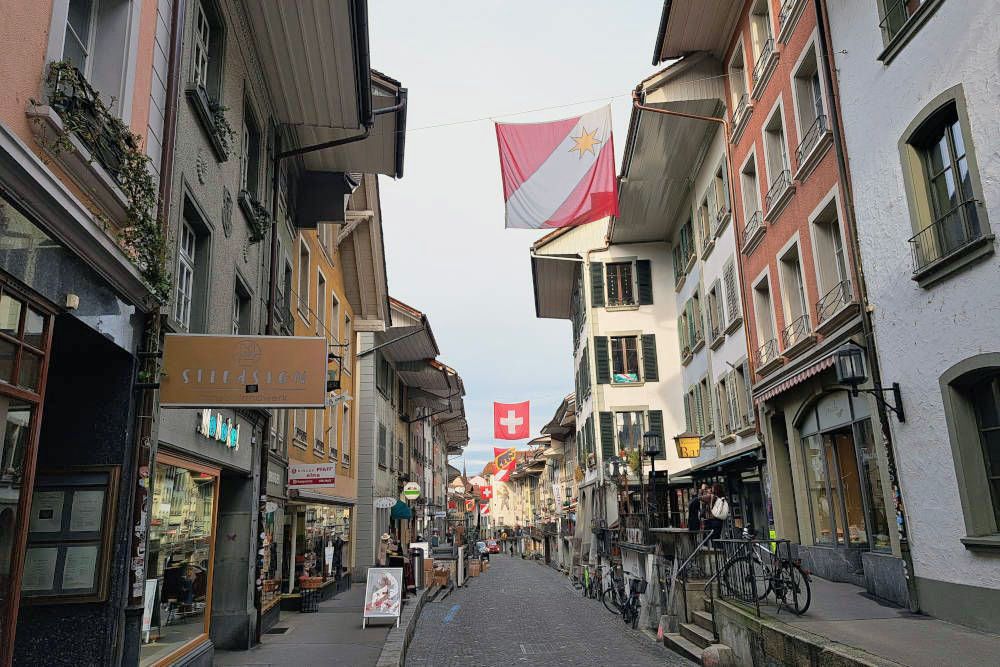
Thun Panorama
The Thun Panorama is an impressive cylindrical painting depicting a panoramic view of the city of Thun and the surrounding Alps. The artist Marquard Wocher created it in 1814 while sitting on the roof in Thun’s city centre. The cylindrical painting has a circumference of about 38 meters and a height of 7 meters. It is the oldest surviving artwork of this kind in the world. The Thun Panorama presents a detailed and realistic view of Thun and the surrounding nature. The painting not only holds artistic value but also serves as a historical document, providing a glimpse of city life and the landscape of Thun in the early 19th century. You can find the Thun Panorama in the park near Schadau Castle.
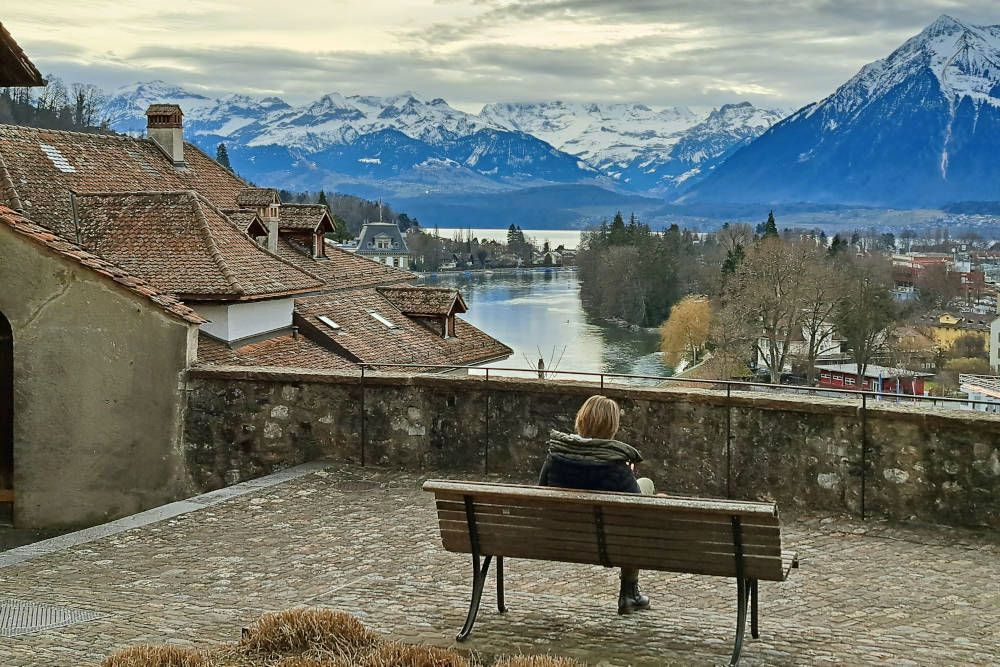
River Aare
The River Aare runs through the heart of Thun. In the river, there is a unique island called Bälliz. It’s enjoyable to visit this island and explore it. You’ll find many historical buildings, narrow streets, and cozy terraces there.
The Aare is home to several beautiful wooden locks, which also serve as bridges. They create a distinctive current in the river, attracting surfers to ride from one lock to another. It’s unique to see a surfing culture even within the city! During the summer, school children also enjoy the locks. They jump in at the first lock and let themselves be carried to the next. A little climb and off they go again. It’s a lovely way to wake up before school starts.
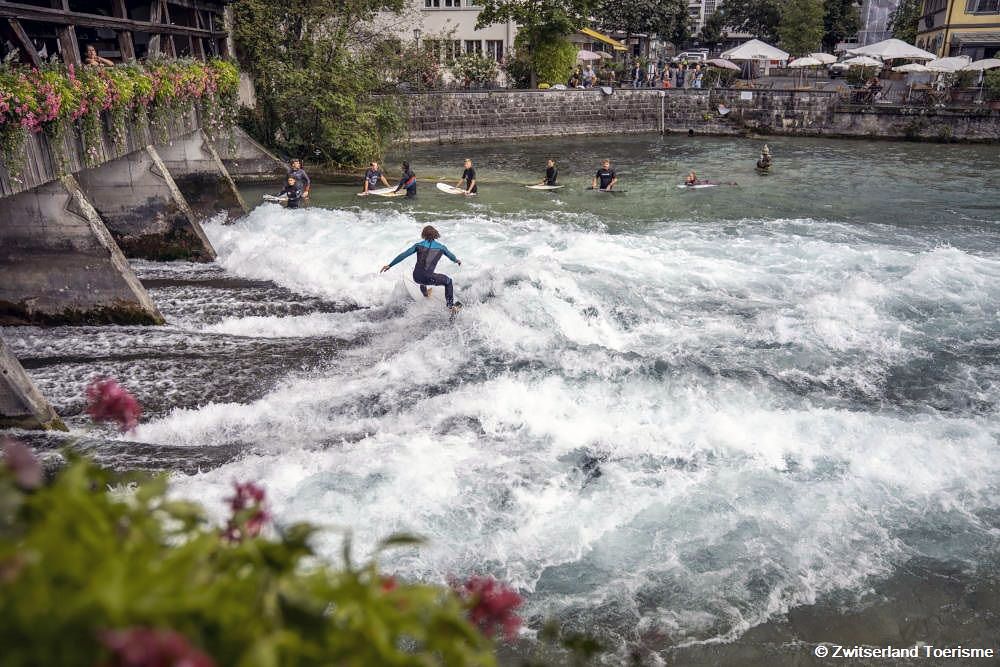
Thun Art Museum
The Thun Art Museum is situated in a historical building on Hofstetten Strasse. The museum focuses on modern and contemporary art. The impressive collection includes paintings, sculptures, and graphic works. The museum regularly hosts changing exhibitions, with a focus on national and international artists.
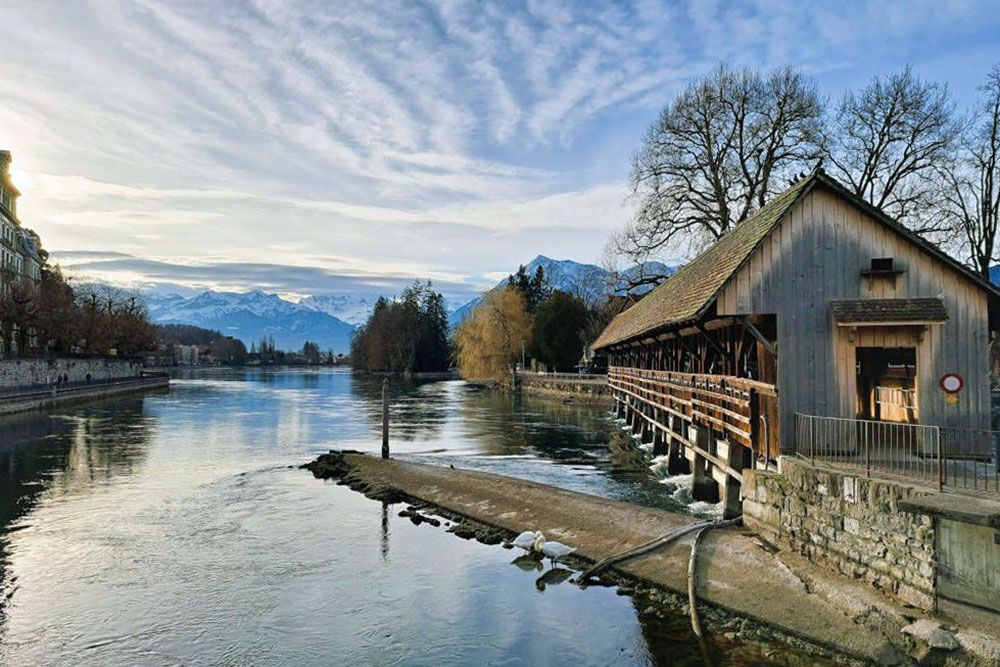
Boat trip on Lake Thun
From the water, you have a wonderful view of Thun, the impressive mountains, and various castles. During your city trip to Thun, a cruise on the lake is a must. There are various excursion boats, two of which are historical paddle steamers. The boats make stops at different locations, ideal for disembarking and exploring the surroundings. The picturesque town of Spiez is a great place to visit.
Being active on (or in) the water is also an option. You can rent stand-up paddleboards, canoes, kayaks, and sailboats, and even go diving in Lake Thun. And if you’ve had your fill of being on the water, there are many hiking trails along the shores of Lake Thun, offering stunning scenery.
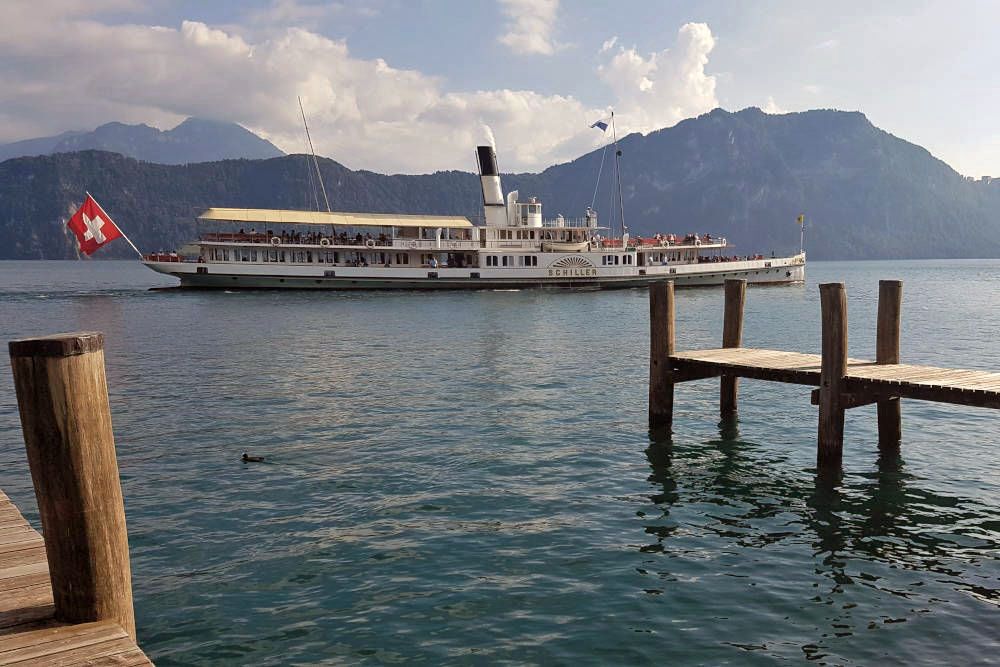
Attractions in the surroundings of Thun
From the lake, you may have already spotted some attractions in the surroundings of Thun. Here are the most remarkable ones:
Oberhofen Castle
Oberhofen Castle is a fairytale-like castle located on the shores of Lake Thun, about five kilometers from the centre of Thun. The castle dates back to the 13th century and now houses a museum with exhibitions on the history of the castle and the region. The beautiful gardens surrounding the castle create a relaxed atmosphere. The magnificent view of the lake and the surrounding mountains is a delightful bonus.
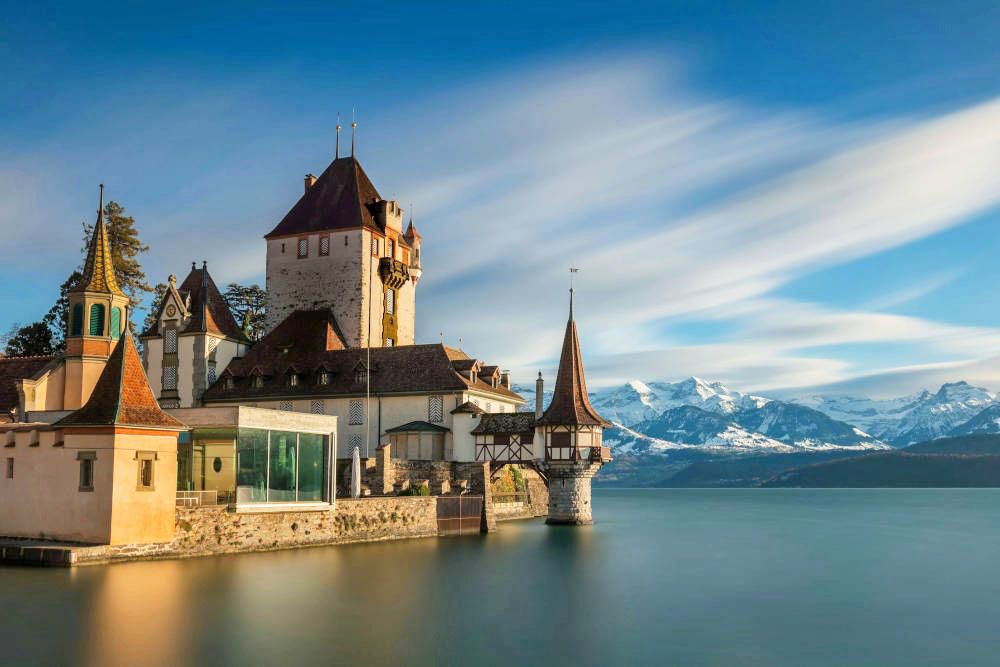
Sigriswil Panorama Bridge
The Sigriswil Panorama Bridge is a remarkable suspension bridge in the vicinity of Thun. With a length of about 350 meters, the bridge spans the valley between the villages of Aeschlen and Sigriswil, making it one of the longest suspension bridges in the country. The bridge hangs approximately 180 meters above the Grafenbach River. From the bridge, you have a spectacular view of the surrounding mountains, Lake Thun, and the picturesque surroundings. You can reach the bridge via hiking trails that run through the surrounding forests and meadows. It’s a popular destination for those who are not afraid of heights!
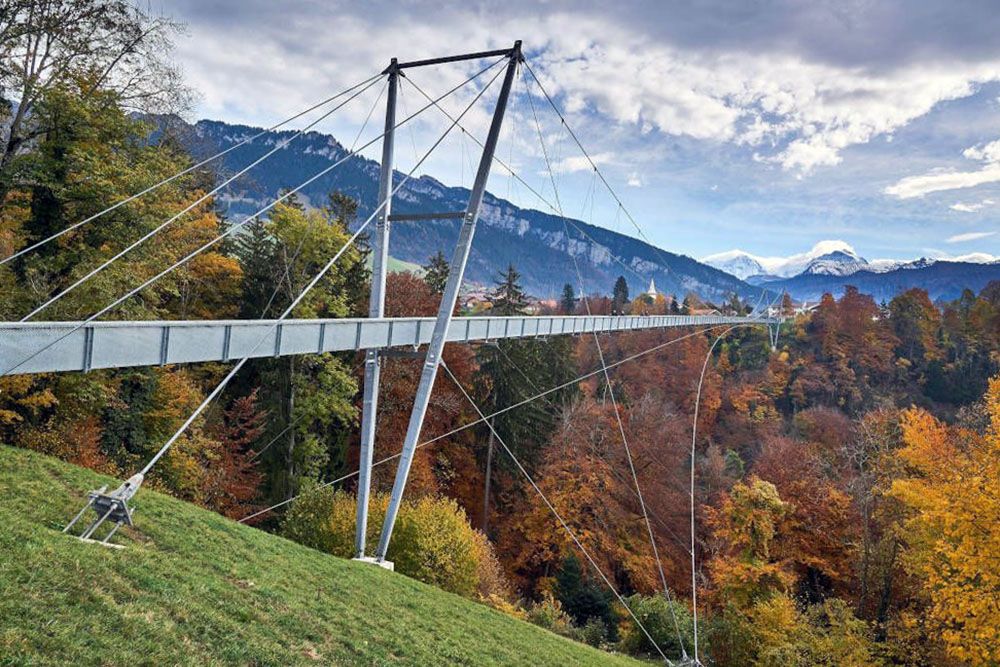
Stockhorn
An even more spectacular vantage point may be the Stockhorn rock, with its distinctive shape. From the top of the rock face, you can look out over Thun, Bern, the Aare Valley, and the Jura. On a clear day, you can spot as many as 200 Alpine peaks! You can reach Stockhorn in two stages with a cable car. You already have a magnificent view from the mountain restaurant. But for an even more impressive experience, head to the free-hanging viewing platform on the north face of the mountain. It’s also handy if you don’t suffer from vertigo, as you’ll be looking down about 400 meters through the glass floor. There are various hiking trails in the vicinity of Stockhorn, allowing you to walk to two idyllic mountain lakes.
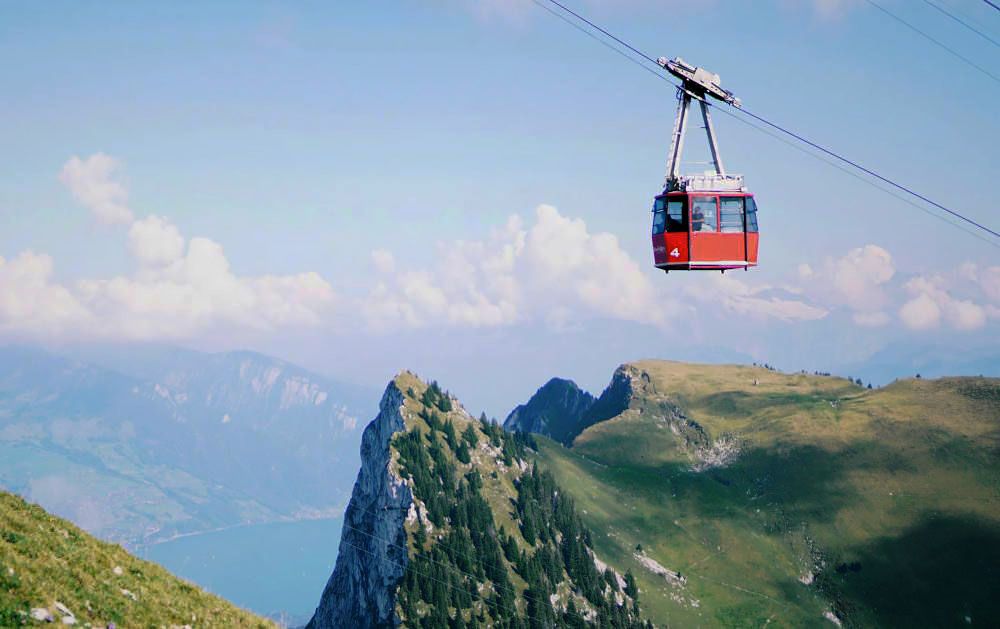
Taking the cable railway to Niesen
With a historic cable car, you can reach the top of Niesen Kulm at almost 2,400 meters in 30 minutes. Needless to say, this also provides an overwhelming 360-degree panorama. Next to the cable car, there is the world’s longest staircase with 11,674 steps. Once a year, sports enthusiasts run up these stairs during the Niesenlauf, which is quite an effort—I’ll pass on that for now.
At Berghaus Niesen, you can enjoy a lovely breakfast, lunch, or dinner. It’s wonderful to witness a sunrise or sunset from here. You can even stay overnight at Berghaus Niesen. We can hardly imagine a more beautiful place.
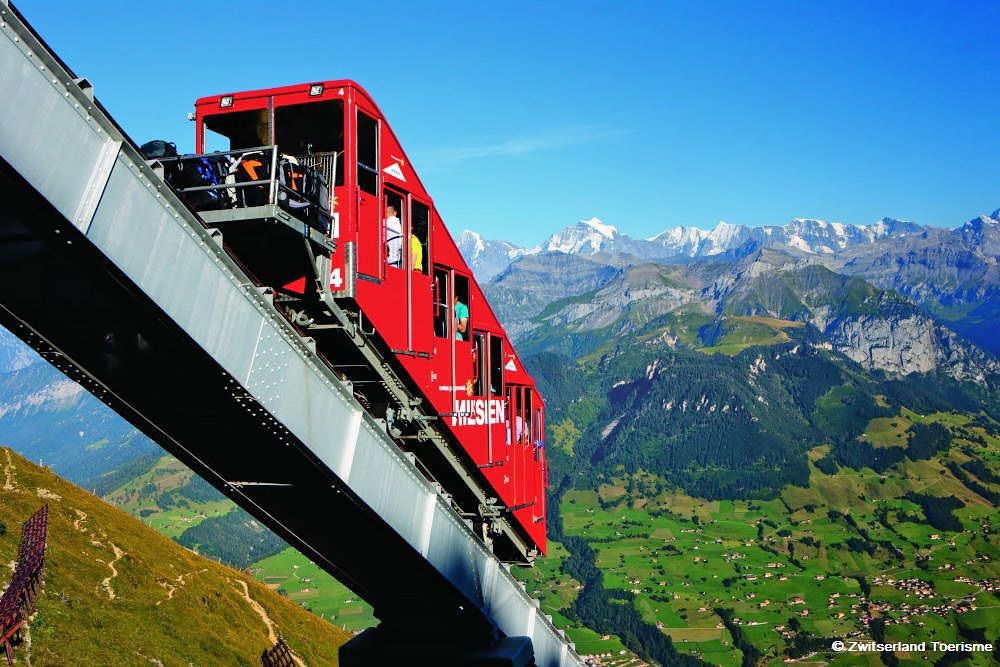
St. Beatus Caves
From overwhelming views of the mountain, we now dive into a mountain—the St. Beatus Caves on Lake Thun, to be precise. These caves are among the 10 largest in the country and are one of the few open to visitors. There is an extensive network of passages, about 14 kilometers in total. Approximately 1 kilometer is accessible to visitors. The walking route on well-maintained paths has an elevation difference of almost 90 meters. Via about 300 steps, you pass by caves, streams, gorges, and waterfalls. This is a great excursion for fans of stalactites and stalagmites. The free audio tour provides a lot of information about the geology, the caves, and how the caves were discovered.
The caves are always around 8 degrees Celsius. So, wear warm clothes when visiting the St. Beatus Caves. Good shoes are also handy. It’s a small climb to reach the cave entrance from the road. Additionally, it’s humid in the caves, so it can be a bit slippery in some places. Although the paths are spacious and high, I still bumped my head a few times.
 |
There is a small car park at St. Beatus Caves. Therefore, it’s best to use public transport (the stop is at the car park). Even better, take a boat trip from Thun and disembark at Beatushöhlen-Sundlauenen. Then, follow a short walk on a well-maintained but slightly uphill path to the entrance. |
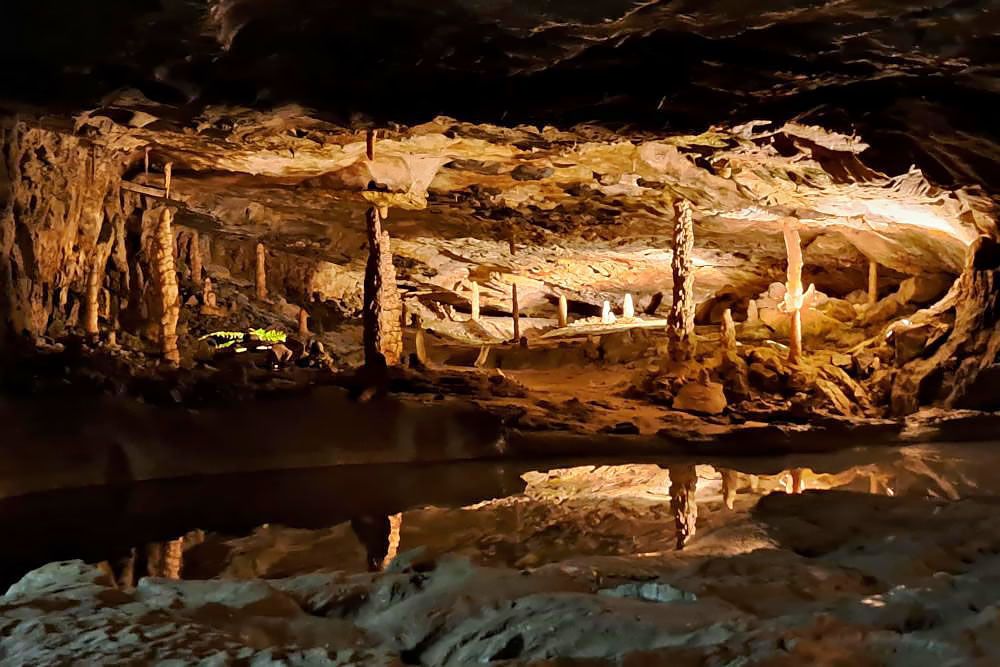
Thun, an ideal base for exploring the region
We were pleasantly surprised by the atmosphere and cosiness of the previously unfamiliar Thun. It is a charming city with plenty of attractions. Additionally, the surrounding area is so beautiful that you could stay there for days, regardless of the season. As far as we’re concerned, Thun is a city waiting to be discovered!
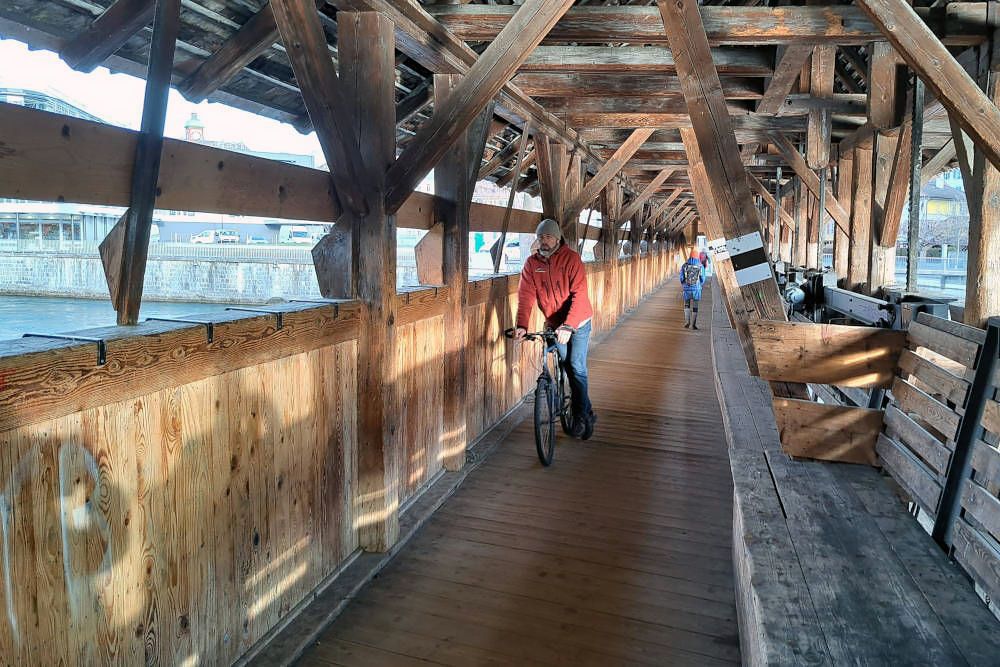
FAQs about Thun and the surrounding area
Thun is situated in the Swiss canton of Berner Oberland, on the northern shore of Lake Thun. The city is approximately 30 kilometers south of Bern.
- Depending on your location, the train is the most comfortable and environmentally friendly way to reach Thun. If possible, travel directly to Basel. From there, a train departs to Thun.
- If travelling by car, you would go via Basel and Bern on the motorway to Thun. Keep in mind that you need a toll sticker for Switzerland.
- Flying is also an option. In this case, take a flight to Zurich. You can then continue your journey by train or rent a car.
- If you plan to use public transport regularly during your stay in Thun, the Swiss Travel Pass is very convenient. With it, you can travel for free by train and bus for the chosen number of days. Even boat connections are included, as well as access to hundreds of museums in the country.
The highlight of Thun is the imposing Thun Castle, which towers high above the city and offers a magnificent view of the city, Lake Thun, and the surrounding Alpine giants. The historic city centre has many charming streets and squares. Hauptgasse is the main street with numerous shops, cafes, and restaurants. The most beautiful square in the city is Rathausplatz with the town hall as its centrepiece. At the Thun Panorama, you can enjoy a large cylindrical painting from 1814.
With so many mountains nearby, Thun boasts some of the most beautiful viewpoints in the region. Stockhorn and Niesen are the most famous. Everywhere, you can enjoy a unique 360-degree panorama of the wider area. Various water sports activities beckon on the glistening Lake Thun. If you prefer a more relaxed pace, explore the lake and its surroundings on a traditional paddle steamer. The St. Beatus Caves offer an impressive view of stalactite formations and rivers that formed millions of years ago.
Every season is suitable for visiting Thun and its surroundings.
- In summer, Thun is a paradise for hikers, cyclists, water sports enthusiasts, and swimmers. You can even watch surfers on the Aare River, right in the city!
- Autumn is the ideal season to explore the museums and enjoy the beautiful autumn colours in the parks.
- During winter, the old town is festively decorated. Naturally, there is a Christmas market, and around carnival time, the city transforms into a lively festival ground. Thanks to the good connections, you can easily reach the snow in the mountains in winter, for example in the Jungfrau Ski Region.
- As nature awakens from its winter slumber in spring, Thun turns into a sea of flowers. It's wonderful to see, and during this time, avid hikers like to head out.
For a delightful dining experience, consider the following restaurants:
- Schloss Schadau Restaurant. Dine in the stylish ambiance of Schadau Castle. It's not cheap, but an experience never to be forgotten.
- Ristorante Beau Rivage da Domenico. Perhaps the best restaurant in the city. Top service, but most importantly, top food.
- Restaurant Dampfschiff. Dine on a ship with a lovely view of Lake Thun. Friendly service and delicious food.
- For the best cocktails and wines, head to Atelier Classic Bar. Beautifully located at Rathausplatz. The bartenders create the most fantastic cocktails.
These are fantastic hotels for a charming overnight stay in Thun:
- Schloss Schadau - Swiss Historic Hotel. Sleep like royalty, ideal for a romantic evening. In good weather, have breakfast on the terrace with a view of Lake Thun.
- Hotel Aare Thun. The location is perfect on Bälliz Island. Stunning view, very close to the train station, ideal for train travellers. Modern hotel with atmosphere.
- Hotel Krone Thun. The location is fantastic, at Rathausplatz in the old town. Excellent hotel with good rooms and service. Parking garage within walking distance.
These are all accommodation options in Thun.
By invitation of Switzerland Tourism and Interlaken Tourism, we visited the Jungfrau Ski Region and surrounding places. The content of the blog was independently and objectively compiled based on our own impressions.
Other topics you may be interested in
- City trip to Zurich
- City trip to Basel
- Jungfrau Ski Region: great winter sports destination
- Mountain hikes on snowshoes, a great experience!
- Highlights of Switzerland

